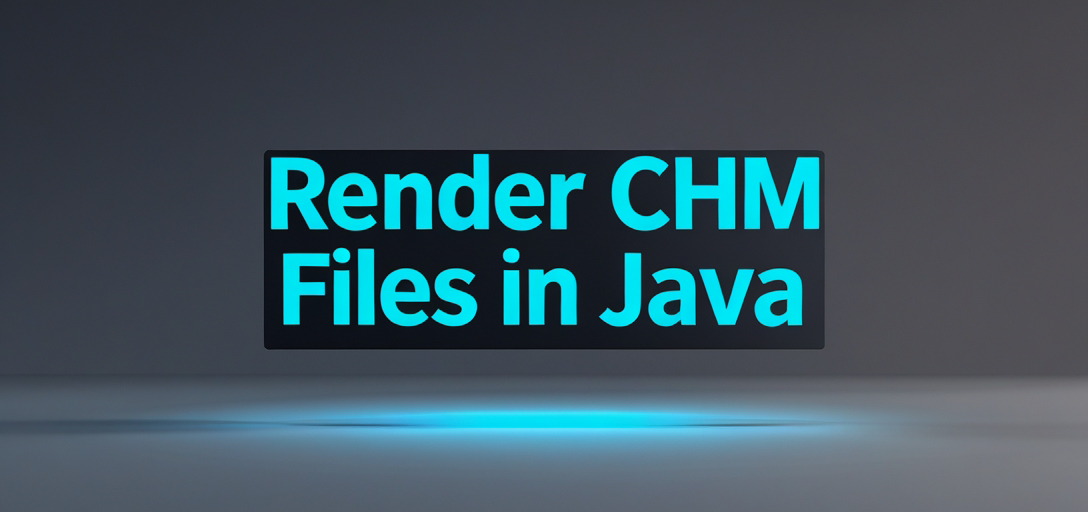How to Render CHM Files Using GroupDocs.Viewer Java: A Comprehensive Guide
Introduction
Are you looking to render Compiled HTML Help (CHM) files into more widely supported formats like HTML, JPG, PNG, and PDF? Whether it’s for archival purposes or enhancing accessibility on various platforms, converting these documents can be a game-changer. This tutorial explores how to seamlessly accomplish this using GroupDocs.Viewer Java. You’ll learn the ins and outs of rendering CHM files efficiently with this powerful library.

What You’ll Learn:
- How to set up GroupDocs.Viewer for Java in your project.
- Step-by-step guides on converting CHM documents to HTML, JPG, PNG, and PDF formats.
- Practical applications and performance considerations when working with document conversion.
Ready to dive into the world of document rendering? Let’s get started by setting up our environment.
Prerequisites
Before we begin, ensure you have the following in place:
- Required Libraries: You’ll need the GroupDocs.Viewer Java library. Ensure you’re using version 25.2 for this tutorial.
- Environment Setup: A basic understanding of Java development environments (e.g., IntelliJ IDEA or Eclipse) is essential.
- Knowledge Prerequisites: Familiarity with Maven and basic Java programming concepts will be helpful.
Setting Up GroupDocs.Viewer for Java
To use GroupDocs.Viewer in your Java project, you’ll need to add it as a dependency. Here’s how you can set it up using Maven: Maven Configuration
<repositories>
<repository>
<id>repository.groupdocs.com</id>
<name>GroupDocs Repository</name>
<url>https://releases.groupdocs.com/viewer/java/</url>
</repository>
</repositories>
<dependencies>
<dependency>
<groupId>com.groupdocs</groupId>
<artifactId>groupdocs-viewer</artifactId>
<version>25.2</version>
</dependency>
</dependencies>
License Acquisition GroupDocs offers a free trial, temporary licenses for evaluation purposes, and purchase options for commercial use. Visit their purchase page or the temporary license section to explore your options. With the library set up, let’s initialize it in a simple Java application:
import com.groupdocs.viewer.Viewer;
public class ViewerSetup {
public static void main(String[] args) {
try (Viewer viewer = new Viewer("path/to/your/document.chm")) {
// Your document viewing and rendering logic goes here.
}
}
}
This snippet demonstrates the basic setup. We’ll build on this foundation as we explore different rendering capabilities.
Implementation Guide
Rendering CHM Document to HTML
Overview Converting a CHM document into an HTML format makes it easily accessible across various web platforms without needing special viewers.
Step 1: Define Output Directory and Naming Pattern
import java.nio.file.Path;
Path outputDirectory = TestFiles.getOutputDirectoryPath("RenderingChmFiles");
Path pageFilePathFormat = outputDirectory.resolve("chm_result_{0}.html");
This step prepares the file system for storing our converted documents, ensuring each HTML page is uniquely named.
Step 2: Configure and Render to HTML
import com.groupdocs.viewer.Viewer;
import com.groupdocs.viewer.options.HtmlViewOptions;
try (Viewer viewer = new Viewer(TestFiles.SAMPLE_CHM)) {
HtmlViewOptions options = HtmlViewOptions.forEmbeddedResources(pageFilePathFormat);
options.setRenderToSinglePage(true); // Optional: render into a single HTML page
viewer.view(options);
}
We initialize HtmlViewOptions with embedded resources, allowing for a self-contained HTML output. The option to consolidate all content into one page is particularly useful for simplifying navigation.
Rendering CHM Document to JPG
Overview For visual representations or thumbnails, converting pages of a CHM document to JPG can be incredibly efficient.
Step 1: Setup Output Directory
Path pageFilePathFormat = outputDirectory.resolve("chm_result_{0}.jpg");
Step 2: Render Specific Pages as JPG
import com.groupdocs.viewer.options.JpgViewOptions;
try (Viewer viewer = new Viewer(TestFiles.SAMPLE_CHM)) {
JpgViewOptions options = new JpgViewOptions(pageFilePathFormat);
viewer.view(options, 1, 2, 3); // Converts pages 1 to 3 into JPG format
}
This configuration allows for selective rendering, providing flexibility in how documents are presented visually.
Rendering CHM Document to PNG
Overview PNG is ideal for high-quality images with transparency support. Converting CHM files to PNG can enhance visual elements of your documentation.
Step 1: Define Output Path
Path pageFilePathFormat = outputDirectory.resolve("chm_result_{0}.png");
Step 2: Configure and Render to PNG
import com.groupdocs.viewer.options.PngViewOptions;
try (Viewer viewer = new Viewer(TestFiles.SAMPLE_CHM)) {
PngViewOptions options = new PngViewOptions(pageFilePathFormat);
viewer.view(options, 1, 2, 3); // Converts specified pages to PNG format
}
Rendering CHM Document to PDF
Overview PDFs are universally accepted formats for documents. Converting a CHM document to PDF makes it easily distributable and accessible.
Step 1: Set Output File Path
Path pageFilePathFormat = outputDirectory.resolve("chm_result.pdf");
Step 2: Render Document as PDF
import com.groupdocs.viewer.options.PdfViewOptions;
try (Viewer viewer = new Viewer(TestFiles.SAMPLE_CHM)) {
PdfViewOptions options = new PdfViewOptions(pageFilePathFormat);
viewer.view(options); // Generates a single PDF document from the CHM file
}
This approach consolidates all content into one easily shareable format, perfect for archival purposes or offline access.
Practical Applications
- Archiving: Convert legacy CHM files into modern formats for easier access and preservation.
- Web Portals: Display CHM documentation as HTML pages on internal company portals.
- Mobile Apps: Provide PDF versions of help documents within mobile applications for enhanced user experience.
Performance Considerations
When dealing with large or numerous document conversions:
- Monitor memory usage, especially when rendering to resource-intensive formats like PNG.
- Optimize your Java environment by adjusting heap sizes if necessary.
- Consider parallel processing techniques for batch conversions to enhance throughput.
Conclusion
You’ve now equipped yourself with the knowledge to convert CHM documents into various formats using GroupDocs.Viewer for Java. This skill set opens up numerous possibilities, from improving document accessibility to integrating legacy content into modern platforms. Why not start experimenting with your own CHM files and explore the potential of these conversion techniques? Ready to take your skills further? Dive into the GroupDocs documentation for more advanced features and customization options.
FAQ Section
Q: Can I convert entire directories of CHM files at once?
A: While GroupDocs.Viewer processes individual documents, you can automate directory processing with a Java script that iterates over files in a folder.
Q: How do I handle large documents without running out of memory?
A: Consider increasing your JVM’s heap size or breaking down the document into smaller parts for conversion.
Q: Is it possible to customize the output formatting further?
A: Yes, GroupDocs.Viewer offers extensive options for customization. Explore the API reference for more details.